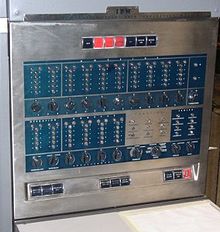
In computing and electronic systems, binary-coded decimal (BCD) is a class of binary encodings of decimal numbers where each digit is represented by a fixed number of bits, usually four or eight. Sometimes, special bit patterns are used for a sign or other indications.
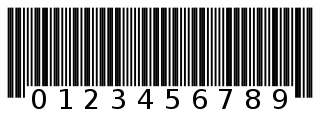
A two-out-of-five code is a constant-weight code that provides exactly ten possible combinations of two bits, and is thus used for representing the decimal digits using five bits. Each bit is assigned a weight, such that the set bits sum to the desired value, with an exception for zero.
The reflected binary code (RBC), also known as reflected binary (RB) or Gray code after Frank Gray, is an ordering of the binary numeral system such that two successive values differ in only one bit.

A binary code represents text, computer processor instructions, or any other data using a two-symbol system. The two-symbol system used is often "0" and "1" from the binary number system. The binary code assigns a pattern of binary digits, also known as bits, to each character, instruction, etc. For example, a binary string of eight bits can represent any of 256 possible values and can, therefore, represent a wide variety of different items.
A binary number is a number expressed in the base-2 numeral system or binary numeral system, a method for representing numbers that uses only two symbols for the natural numbers: typically "0" (zero) and "1" (one). A binary number may also refer to a rational number that has a finite representation in the binary numeral system, that is, the quotient of an integer by a power of two.
Excess-3, 3-excess or 10-excess-3 binary code, shifted binary or Stibitz code is a self-complementary binary-coded decimal (BCD) code and numeral system. It is a biased representation. Excess-3 code was used on some older computers as well as in cash registers and hand-held portable electronic calculators of the 1970s, among other uses.
Quinary is a numeral system with five as the base. A possible origination of a quinary system is that there are five digits on either hand.
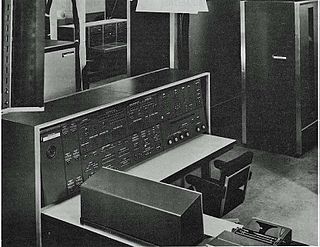
The UNIVAC LARC, short for the Livermore Advanced Research Computer, is a mainframe computer designed to a requirement published by Edward Teller in order to run hydrodynamic simulations for nuclear weapon design. It was one of the earliest supercomputers. It used solid-state electronics.
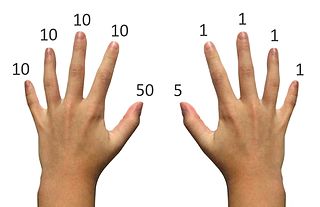
Chisanbop or chisenbop, sometimes called Fingermath, is a finger counting method used to perform basic mathematical operations. According to The Complete Book of Chisanbop by Hang Young Pai, chisanbop was created in the 1940s in Korea by Sung Jin Pai and revised by his son Hang Young Pai, who brought the system to the United States in 1977.
Chen–Ho encoding is a memory-efficient alternate system of binary encoding for decimal digits.
A ring counter is a type of counter composed of flip-flops connected into a shift register, with the output of the last flip-flop fed to the input of the first, making a "circular" or "ring" structure.

A reed relay is a type of relay that uses an electromagnet to control one or more reed switches. The contacts are of magnetic material and the electromagnet acts directly on them without requiring an armature to move them. Sealed in a long, narrow glass tube, the contacts are protected from corrosion. The glass envelope may contain multiple reed switches or multiple reed switches can be inserted into a single bobbin and actuate simultaneously. Reed switches have been manufactured since the 1930s.
A six-bit character code is a character encoding designed for use on computers with word lengths a multiple of 6. Six bits can only encode 64 distinct characters, so these codes generally include only the upper-case letters, the numerals, some punctuation characters, and sometimes control characters. The 7-track magnetic tape format was developed to store data in such codes, along with an additional parity bit.

Gillham code is a zero-padded 12-bit binary code using a parallel nine- to eleven-wire interface, the Gillham interface, that is used to transmit uncorrected barometric altitude between an encoding altimeter or analog air data computer and a digital transponder. It is a modified form of a Gray code and is sometimes referred to simply as a "Gray code" in avionics literature.
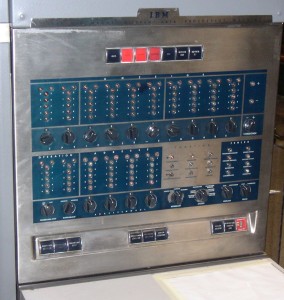
A decimal computer is a computer that can represent numbers and addresses in decimal and that provides instructions to operate on those numbers and addresses directly in decimal, without conversion to a pure binary representation. Some also had a variable wordlength, which enabled operations on numbers with a large number of digits.
In digital computing and telecommunications, a unit of information is the capacity of some standard data storage system or communication channel, used to measure the capacities of other systems and channels. In information theory, units of information are also used to measure information contained in messages and the entropy of random variables.
Offset binary, also referred to as excess-K, excess-N, excess-e, excess code or biased representation, is a method for signed number representation where a signed number n is represented by the bit pattern corresponding to the unsigned number n+K, K being the biasing value or offset. There is no standard for offset binary, but most often the K for an n-bit binary word is K = 2n−1 (for example, the offset for a four-digit binary number would be 23=8). This has the consequence that the minimal negative value is represented by all-zeros, the "zero" value is represented by a 1 in the most significant bit and zero in all other bits, and the maximal positive value is represented by all-ones (conveniently, this is the same as using two's complement but with the most significant bit inverted). It also has the consequence that in a logical comparison operation, one gets the same result as with a true form numerical comparison operation, whereas, in two's complement notation a logical comparison will agree with true form numerical comparison operation if and only if the numbers being compared have the same sign. Otherwise the sense of the comparison will be inverted, with all negative values being taken as being larger than all positive values.
BCD, also called alphanumeric BCD, alphameric BCD, BCD Interchange Code, or BCDIC, is a family of representations of numerals, uppercase Latin letters, and some special and control characters as six-bit character codes.

The Aiken code is a complementary binary-coded decimal (BCD) code. A group of four bits is assigned to the decimal digits from 0 to 9 according to the following table. The code was developed by Howard Hathaway Aiken and is still used today in digital clocks, pocket calculators and similar devices.
The FACOM 128 was a relay-based electromechanical computer built by Fujitsu. Two models were made, namely the FACOM 128A, built in 1956, and the FACOM 128B, built in 1959. As of 2019, a fully working FACOM 128B is still in working order, maintained by Fujitsu staff at a facility in Numazu in Shizuoka Prefecture.



